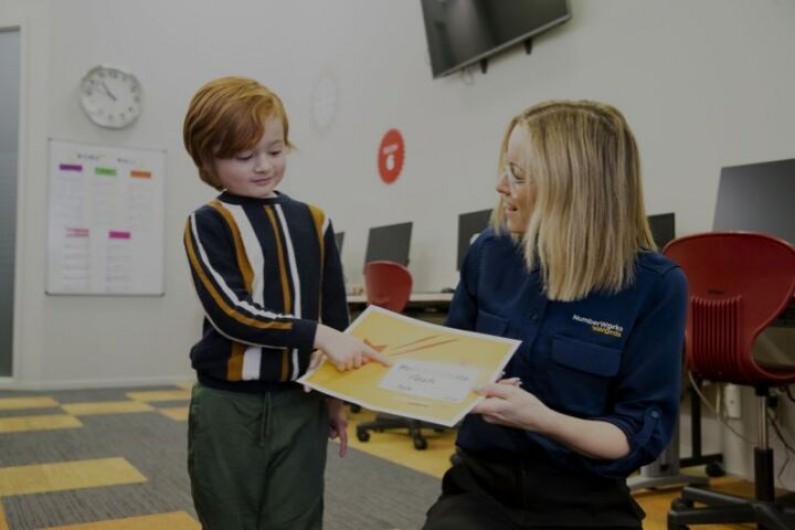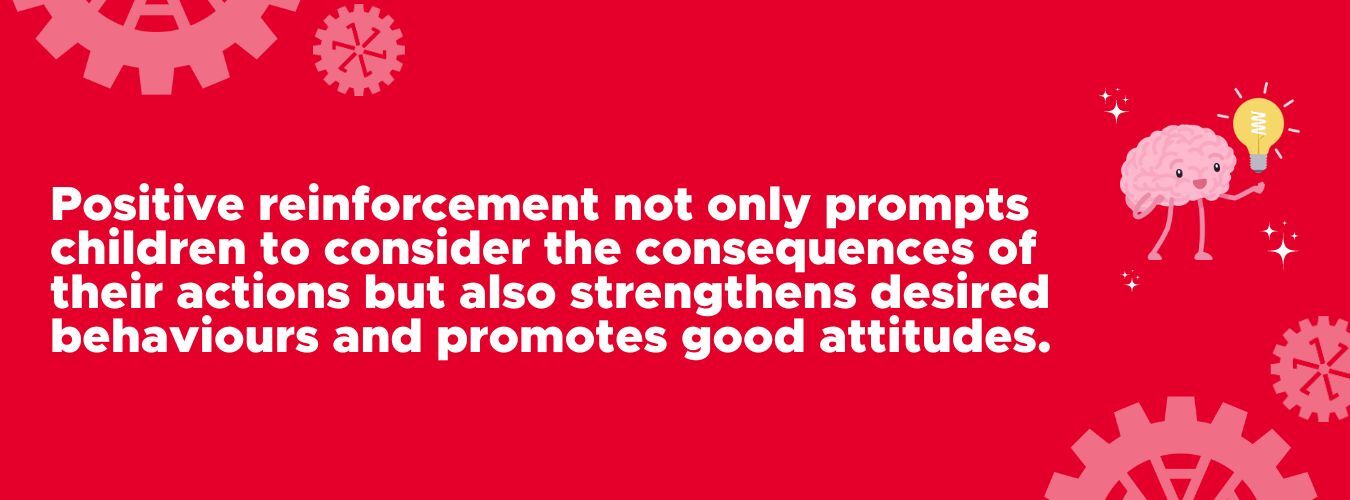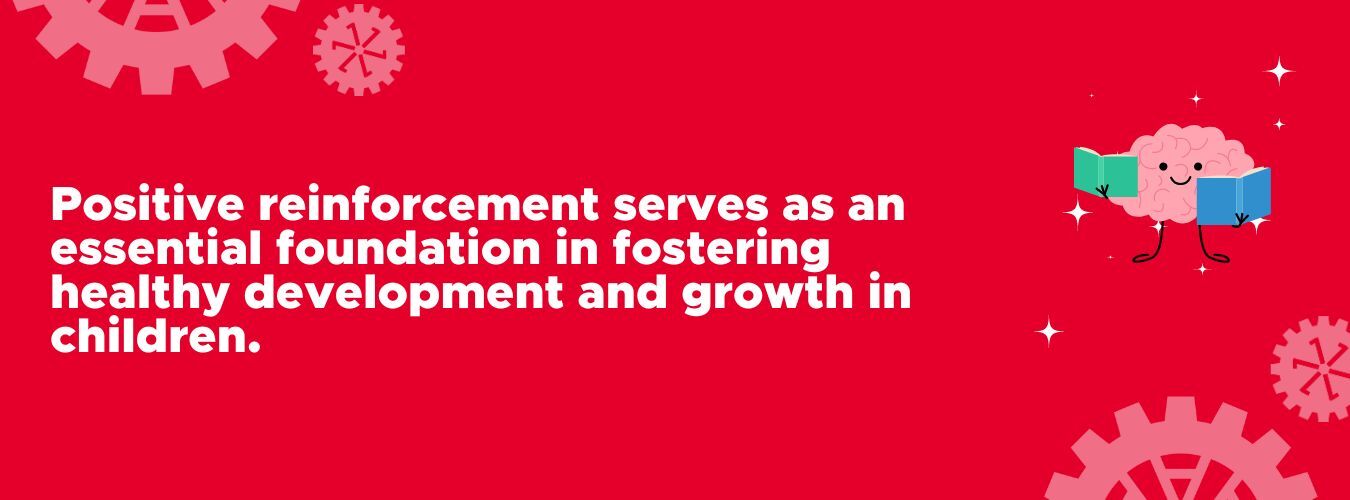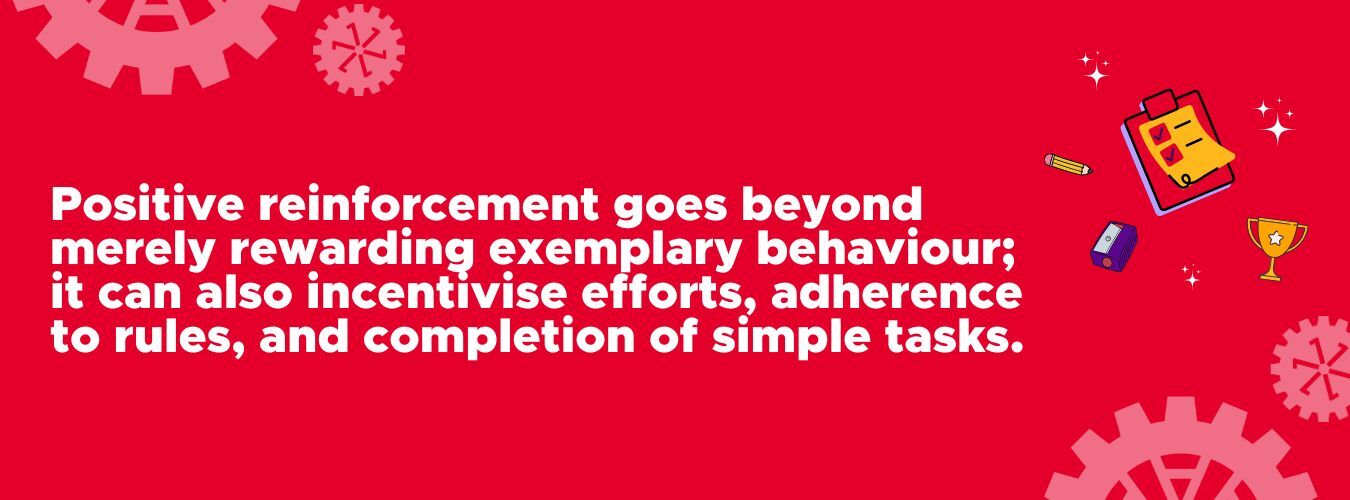Unlocking the Potential of Positive Reinforcement

In the journey of learning, whether it involves mastering a new skill, grasping complex concepts, or fostering personal growth, positive reinforcement plays a huge role in increasing encouragement and motivation. Its influence goes beyond mere praise or material rewards; it moulds the attitudes, behaviours, and ultimately, the success of our children.
In this blog, we'll delve into the impact of positive reinforcement on learning and explore practical strategies for implementing it with your children. Parenting comes with its share of challenges, especially when faced with resistance from our kids.
Positive reinforcement not only prompts children to consider the consequences of their actions but also strengthens desired behaviours and promotes good attitudes.

What is Positive Reinforcement?
Positive reinforcement is a strategic method that prioritises the cultivation of specific behaviours through positive outcomes rather than negative repercussions. Instead of employing immediate negative consequences, such as taking something away, positive reinforcement involves offering something pleasant or desirable to encourage positive actions in children.
For example, promising your child a trip to the park in exchange for completing a desirable behaviour, like tidying their room, makes that behaviour more appealing and increases the likelihood of its recurrence. Conversely, threatening to discard their toys if they fail to tidy up is less effective in reinforcing behaviour, as it may lack credibility or lead to resentment and undesirable conduct.
Types of Positive Reinforcement
Positive reinforcement manifests in various forms, including:
- Natural: Occurs organically, such as diligently studying leading to high marks and praise.
- Tangible: Involves physical rewards like money or treats in response to the desired behaviour.
- Social: Comprises praise and compliments from teachers, peers or adults serving as reinforcement.
- Token: Involves rewards given for specific behaviours, often exchangeable, as seen in reward charts where children earn stickers for chores.
Examples of Positive Reinforcement for Children
Positive reinforcement goes beyond merely rewarding exemplary behaviour; it can also incentivise efforts, adherence to rules, and completion of simple tasks. Here are various methods to utilise positive reinforcement in rewarding specific behaviours in your children:
- Granting additional privileges, such as extended screen time or the choice of dinner.
- Offering verbal praise and sharing their accomplishments with others.
- Providing non-verbal gestures like hugs or high-fives.
- Offering monetary rewards for completed chores, thereby fostering money management skills.
- Utilising descriptive praise, especially effective with teenagers, to highlight specific commendable behaviours.
Linking Rewards to Positive Behaviours
The way we react to children's behaviour influences their actions and the probability of certain behaviours recurring, through a process called operant conditioning. By consistently associating behaviour modification with rewards, we can foster the emergence of new behavioural patterns.
For instance, a child is more likely to tidy their room promptly if they expect a reward. Rewards serve as incentives for desired behaviour.
Distinguishing Positive from Negative Reinforcement
Positive reinforcement enhances a behaviour by introducing a favourable outcome for negative or undesirable behaviour, such as praise. Conversely, negative reinforcement involves removing an aversive stimulus when the desired behaviour is exhibited.
For example, granting extra screen time for completed chores demonstrates positive reinforcement, while withholding screen time until chores are finished illustrates negative reinforcement.

Appropriate Use of Reinforcement Schedules
When ongoing conflicts emerge concerning tasks such as homework or chores, establishing a reinforcement schedule can provide organisation. Maintaining a consistent schedule is essential to uphold clarity, reinforce behaviour, encourage desired actions, and align rewards with both your and your child's preferences. Understanding your child's motivations is key to implementing effective reinforcement.
Addressing Concerns about Positive Reinforcement
Although positive reinforcement is an effective means of shaping human behaviour, concerns about it resembling bribery or undermining intrinsic motivation may surface. However, positive reinforcement training distinguishes itself from bribery through its proactive approach and emphasis on predetermined incentives and specific behaviours. Additionally, as adults, we frequently undertake tasks with intermittent reinforcement and anticipate rewards, highlighting its prevalence in behaviour regulation.
Enhancing Communication and Connection
Positive reinforcement not only influences a child's behaviour but also strengthens the parent-child bond through positive stimuli. Consistently recognising and praising desired behaviours fosters a supportive environment of mutual respect and understanding.
Furthermore, fostering open communication about the reinforcement process encourages children to voice their needs and preferences, promoting a collaborative approach to behaviour management.
Fostering Independence and Self-Regulation
Positive reinforcement not only encourages positive behaviours in children, but also fosters independence and self-regulation by equipping them with the tools to identify and pursue intrinsic rewards. As children grasp the connection between their actions and the resulting positive outcomes, they develop intrinsic motivation to maintain desirable behaviours. This process lays the groundwork for lifelong self-discipline and resilience.

Promoting a Growth Mindset
Positive reinforcement fosters a growth mindset by shaping behaviour, encouraging children to view challenges and setbacks as opportunities for growth rather than obstacles. By consistently using positive reinforcement to acknowledge efforts and progress alongside achievements, parents instill a mindset that values perseverance and embraces learning from setbacks. This mindset equips children with resilience and optimism, essential qualities for confidently navigating life's challenges.
In conclusion, positive reinforcement empowers parents to effectively cultivate desired behaviours in their children. While it may not always be the perfect approach for every behaviour, its adaptability and effectiveness make it a valuable tool in nurturing positive development. Ultimately, parental discretion in both positive and negative consequences ensures that consequences align with individual needs and circumstances.
Positive reinforcement serves as an essential foundation in fostering healthy development and growth in children. Its effectiveness extends beyond immediate behavioural changes, influencing long-term attitudes and habits. By leveraging positive reinforcement, parents can mitigate negative behaviours and create supportive environments where children thrive.
Here at NumberWorks’nWords we understand the importance of positive reinforcement and provide personalised tuition for each child to ensure they are getting the best support possible. Our tutoring boosts confidence and results!
Our tuition complements schoolwork and follows the curriculum, to support students with their academic goals. To learn more about how NumberWorks’nWords tuition can help your child, get in touch with the team, or book a free assessment and introductory lesson to start their journey today.




